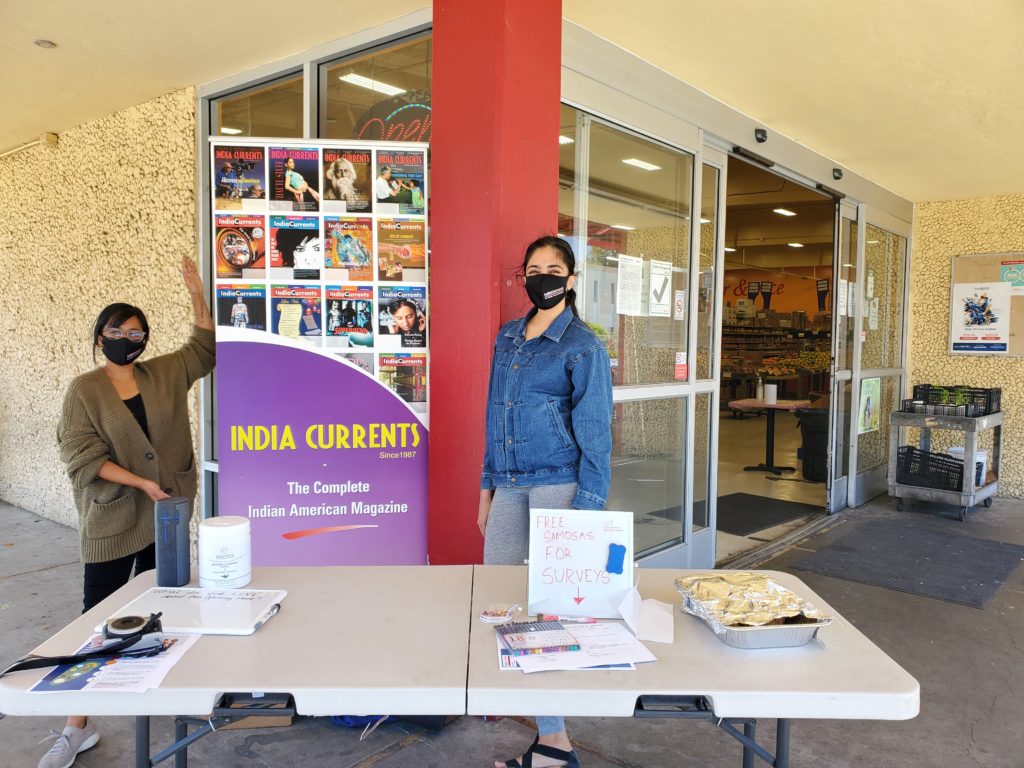Q&A with Vandana Kumar: How India Currents engages audiences authentically
This Q&A is part of a new INN series on how nonprofit news outlets serve communities of color. You can find more Q&As here.
Who: Vandana Kumar, Publisher and CEO
News outlet: India Currents
Size of outlet as of January 2022: 3.5 full-time employees
Outlet launch year: 1987 as a print magazine, 2019 as a nonprofit
Vandana, please tell us a bit about your news outlet. What sort of services does India Currents provide? What’s your outlet’s primary mission?
India Currents has documented the life of Indian Americans in the Bay Area and Silicon Valley for over 30 years. Our deep roots in the community make us a trusted messenger on critical issues. Our community journalism draws on diverse perspectives from our multiethnic audience and from community partnerships that facilitate cross-cultural communications.
We are an incubator for journalists of color and our archives provide an indispensable resource for Bay Area history. As conveners of community, we play a distinctive role in connecting Indian Americans to each other and in transcending cultural silos to support social justice issues in civic life.
Tell us about yourself! When did you start working at India Currents? What does your role look like?
I came to the Bay Area in 1986, a pre-internet era. Unfamiliar with my surroundings, I avidly read the newspaper every morning hoping to find stories that I could relate to. A war on drugs, the Iran-Contra affair and the Dow Jones dominated the space. Immigrants like me were invisible.
To fill this void, we launched India Currents magazine in 1987 with the initial mission to connect immigrants from India, learn from shared experiences and discover resources for assimilation in our new homeland.
I’ve held every role at India Currents — from selling ads to serving as events editor and managing editor — to my current role as publisher and CEO. Now I oversee editorial priorities and administration but focus on fundraising and building community alliances.
Who does your outlet primarily serve, and how do you know this? Is your current audience different from who your outlet intends to serve?
India Currents represents the Bay Area Indian American immigrant community. We started by distributing our print magazine locally — at Indian grocery stores and restaurants — to reach new immigrants. We ran surveys to understand their needs. Stories about assimilation in the US were very popular.

In 2018 we became 100% digital. Now our local stories draw readers from around the world, as well as our Bay Area audience. Stories with cultural ties still resonate with our readers.
Through audience analytics, surveys and community outreach, we keep a finger on the pulse of our multilingual community and the issues that matter to them.
Google Analytics says we reach over 120,000 users, over 60,000 social media followers, 15,000 email subscribers and 45,000 unique visitors to the website every month. Our audience includes women (49.3%) and men (50.7%) aged 25 to 65.
Our latest survey shows 55% of our audience is interested in heritage arts and culture, while 45% want information on social impact issues and stories on immigrant life in America. About 35% enjoy community opinions on every topic.
Tell us a bit more about the coverage India Currents produces. How do you determine the stories to tell that will most help or most impact your target audience?
We offer the Indian American community a platform to share familiar stories, explore hyphenated identities and discover how they can participate in local and civic engagement.
Our content has evolved over the years. We initially focused on culture and heritage to preserve links to India, but, as the booming tech industry drew thousands of Indian people to Silicon Valley as IT talent, our content responded to their needs. We ran stories on raising families in a new homeland, the dilemma of being immigrants on H-4 and H-1B visas, crises in the community, representation in the media and the struggle between acculturation and assimilation.
Today, as a nonprofit, we focus on social issues that impact our lives and guide new immigrants into the mainstream. We run stories on why census participation and voting matter; we showcase Indian American contenders for political office and keep readers updated about the COVID-19 pandemic, activism, elections, climate change and redistricting, among other topics of critical import.
Could you tell us about your community storyteller program?
We modeled India Currents on the Metro, a weekly magazine that was a great resource for local happenings. Due to limited funds when we launched, we reached out to readers for tips on upcoming events and asked them to share stories about their lives.
Today that’s called “crowdsourcing!”
Community storytellers were eager to share their stories with a wider audience. There was no other platform where everyday readers could submit their stories. Our writers had day jobs and writing was a hobby. Nevertheless, they grew experienced in the craft of writing, helped by our in-house editors. Several of our contributors went on to get published in the mainstream press and signed book deals after getting their start at India Currents. Some of them, like Sandip Roy, Kalpana Mohan and Jaya Padmanabhan, are now recognized writers and speakers.
We still crowdsource stories from our community and our team of editors selects, edits and publishes them. Every month, we send an email out suggesting a theme and seeking stories that speak to the zeitgeist. In 2020, for example, our audience shared stories on the pandemic-enforced new normal, BLM’s impact and the first woman of color on the presidential ticket.
We have a youth editor who curates stories for the next generation who see India Currents as a bridge to their culture and heritage.
Every year we also sponsor a cohort of high school and college students who we mentor and train. Our process invites emerging writers to share their work under the guidance of our experienced editors. Several of our interns have become professional writers.
How do you track the impact of this work, both the editorial coverage and the storyteller program?
We use Google Analytics to track the reach of every article and give us insight into what resonates with the community.
Our editorial team works closely with contributors to develop each story — whether it’s an original piece or one we’ve commissioned. This year we had contributions from 128 community journalists.
Our award-winning stories reflect the impact of this work — and validate our model. In 2020, ten of our writers won awards from the San Francisco Press Club. Seven writers won recognition at the California Journalism Awards hosted by the California News Publishers Newspapers Association, for coverage of the COVID-19 pandemic, and fallout, as well as coverage of local elections.
“Our strategy with funders is to highlight the unique value we deliver to a niche community — but sometimes that’s not enough to win the funding we desperately need to scale up or invest in infrastructure. Since we are unknown to the grants/foundations world, we’ve learned we need allies to vouch for us.”
Vandana kumar
Some ethnic media outlets tell us that funders can struggle to understand the value an outlet like India Currents provides. Do you relate to this? What tactics are most effective in communicating your work to the funder community?
Yes! I absolutely relate to this! Here are some comments I have heard from funders: “We don’t care for cultural stories. What’s the public good?” Or, “You have an international and national lens and do not focus on the news and information needs of local underserved communities.”
All ethnic media have dedicated audiences because their reporting is through a cultural lens. But it’s a stepping stone for engaging audiences in broader inter-ethnic communication and in diversifying the wider civic realm.
Our strategy with funders is to highlight the unique value we deliver to a niche community — but sometimes that’s not enough to win the funding we desperately need to scale up or invest in infrastructure. Since we are unknown to the grants/foundations world, we’ve learned we need allies to vouch for us.
Having champions to boost our value has gotten a funder’s attention. For now, that’s been an effective tactic in communicating our work to the funder community.
Anything else you want to mention about how India Currents serves people of color in your community?
We offer a unique model for community journalism. We’ve successfully engaged with our desi target audience for over 30 years by offering authentic storytelling by and for people of color.
We’ve stayed true to our mission. And we’ve used innovative methods to make sure we reach our readers, wherever they may be — last year we promoted the census by collaborating with our network of community leaders to reach their followers via WhatsApp. We’ve also developed partnerships with other local outlets — Ethnic Media Services, DingDing TV, and East Palo Alto Center for Community Media — so we can collaborate on initiatives for greater social impact.
India Currents is led by a majority-female editorial team and board of people of color. Our staff represent the diversity of the people we serve.
What advice do you have for other news organizations who want to better serve people of color within their communities?
Our longstanding roots in the community make us a trusted messenger. So, grow roots in the community you want to serve. Reach out and connect with your intended audience to understand what matters to them. Then deliver that. Don’t assume you know what they want.
What’s next? Is there a story you’re looking forward to in 2022?
I got a new story idea when I heard from a reader who had moved into an active senior living facility in Southern California. After retiring from a successful career, he is struggling to feel visible in his new environment. Since there is a growing South Asian population that is aging, we are wondering: are senior living facilities prepared for this diversity? That’s a story we will explore in 2022.
What’s next for us? The challenge for India Currents, and all ethnic media, is finding a sustainable model for this community representation. Building a new revenue model using memberships is a daunting task for most small outfits. It requires resources, knowledge, mentoring and a tech stack that is vital for these operations. That’s going to be my focus in 2022!
Read more from the series here.
